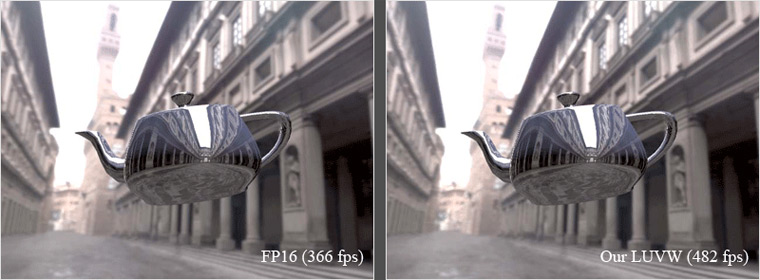Rendering from Compressed High Dynamic Range Textures on Programmable Graphics Hardware
- Microsoft Research Asia
- *Microsoft Corporation

A visual comparison between 16-bit floating-point format and our compressed HDR texture format.
Abstract
In this paper, we perform extensive study of possible methods for supporting compressed HDR textures on commodity graphics hardware. A desirable solution must be implementable on DX9 generation hardware, as well as meet the following requirements. First, the data size should be small and the reconstruction quality must be good. Second, the decompression must be efficient; in particular, bilinear/trilinear/anisotropic texture filtering ought to be performed via native texture hardware instead of custom pixel shader filtering. We present a solution that optimally meets these requirements. Our basic idea is to convert a HDR texture to a custom LUVW space followed by an encoding into a pair of 8-bit DXT textures. Since DXT format is supported on modern commodity graphics hardware, our approach has wide applicability. Our compression ratio is 3:1 for FP16 inputs, allowing applications to store 3 times the number of HDR texels in the same memory footprint. Our decompressor is efficient and can be implemented as a short pixel program. We leverage existing texturing hardware for fast decompression and native texture filtering, allowing HDR textures to be utilized just like traditional 8-bit DXT textures. Our reduced data size has a further advantage: it is even faster than rendering from uncompressed HDR textures due to our reduced texture memory access. Given the quality and efficiency, we believe our approach suitable for games and interactive applications.
Keywords
High Dynamic Range Image, Texture Compression, Games & GPUs, Game Programming, Graphics Hardware, Texturing Techniques
Downloads
- Paper .pdf | 2.3 MB
- I3D 2007 Slides .ppt | 25.9 MB
Acknowledgements
We would like to thank Meng Qiang and Xianyou Hou for help on early experiments and the anonymous reviewers for their comments.